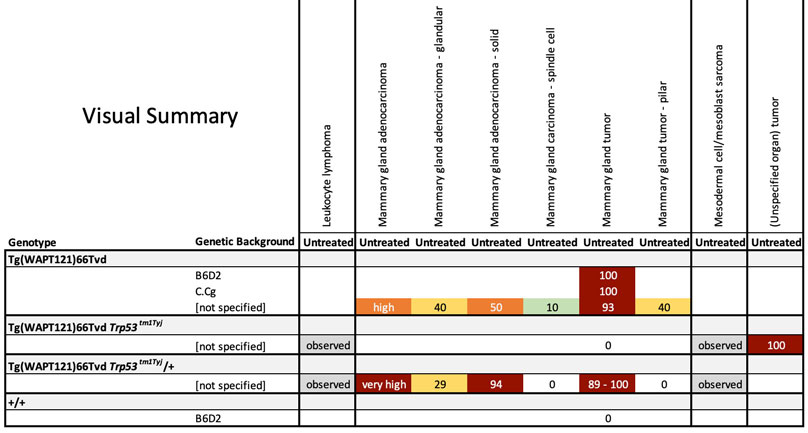Reference SummarySimin K, PLoS Biol 2004 Feb;2(2):E22
Title |
pRb Inactivation in Mammary Cells Reveals Common Mechanisms for Tumor Initiation and Progression in Divergent Epithelia. | ||||||||||||||
Authors |
Simin K; Wu H; Lu L; Pinkel D; Albertson D; Cardiff RD; Dyke TV | ||||||||||||||
Journal |
PLoS Biol | ||||||||||||||
Volume |
2 | ||||||||||||||
Issue |
2 | ||||||||||||||
Year |
2004 | ||||||||||||||
Pages |
E22 | ||||||||||||||
Abstract |
Retinoblastoma 1 (pRb) and the related pocket proteins, retinoblastoma-like 1 (p107) and retinoblastoma-like 2 (p130) (pRb(f), collectively), play a pivotal role in regulating eukaryotic cell cycle progression, apoptosis, and terminal differentiation. While aberrations in the pRb-signaling pathway are common in human cancers, the consequence of pRb(f) loss in the mammary gland has not been directly assayed in vivo. We reported previously that inactivating these critical cell cycle regulators in divergent cell types, either brain epithelium or astrocytes, abrogates the cell cycle restriction point, leading to increased cell proliferation and apoptosis, and predisposing to cancer. Here we report that mouse mammary epithelium is similar in its requirements for pRb(f) function; Rb(f) inactivation by T(121), a fragment of SV40 T antigen that binds to and inactivates pRb(f) proteins, increases proliferation and apoptosis. Mammary adenocarcinomas form within 16 mo. Most apoptosis is regulated by p53, which has no impact on proliferation, and heterozygosity for a p53 null allele significantly shortens tumor latency. Most tumors in p53 heterozygous mice undergo loss of the wild-type p53 allele. We show that the mechanism of p53 loss of heterozygosity is not simply the consequence of Chromosome 11 aneuploidy and further that chromosomal instability subsequent to p53 loss is minimal. The mechanisms for pRb and p53 tumor suppression in the epithelia of two distinct tissues, mammary gland and brain, are indistinguishable. Further, this study has produced a highly penetrant breast cancer model based on aberrations commonly observed in the human disease. | ||||||||||||||
Links |
J:88315 – MGI References 14966529 – National Library of Medicine/PubMed |
||||||||||||||
Strain Notes
|
|||||||||||||||

| |||||||||||||||
| Strain | Model Name | Treatment Agent(s) | Organ Affected | Frequency | Model Details |
|---|---|---|---|---|---|
| [not specified]-Tg(WAPT121)66Tvd Trp53tm1Tyj/+ | Leukocyte lymphoma | Thymus |
observed |
||
| [not specified]-Tg(WAPT121)66Tvd Trp53tm1Tyj | Leukocyte lymphoma | Thymus |
observed |
||
| [not specified]-Tg(WAPT121)66Tvd Trp53tm1Tyj/+ | Mammary gland adenocarcinoma | Mammary gland |
very high |
||
| [not specified]-Tg(WAPT121)66Tvd | Mammary gland adenocarcinoma | Mammary gland |
high |
||
| [not specified]-Tg(WAPT121)66Tvd Trp53tm1Tyj/+ | Mammary gland adenocarcinoma - glandular | Mammary gland |
29 |
||
| [not specified]-Tg(WAPT121)66Tvd | Mammary gland adenocarcinoma - glandular | Mammary gland |
40 |
||
| [not specified]-Tg(WAPT121)66Tvd Trp53tm1Tyj/+ | Mammary gland adenocarcinoma - solid | Mammary gland |
94 |
||
| [not specified]-Tg(WAPT121)66Tvd | Mammary gland adenocarcinoma - solid | Mammary gland |
50 |
||
| [not specified]-Tg(WAPT121)66Tvd Trp53tm1Tyj/+ | Mammary gland carcinoma - spindle cell | Mammary gland |
0 |
||
| [not specified]-Tg(WAPT121)66Tvd | Mammary gland carcinoma - spindle cell | Mammary gland |
10 |
||
| B6D2 | Mammary gland tumor | Mammary gland |
0 |
||
| B6D2-Tg(WAPT121)66Tvd | Mammary gland tumor | Mammary gland |
100 |
||
| C.Cg-Tg(WAPT121)66Tvd | Mammary gland tumor | Mammary gland |
100 |
||
| [not specified]-Tg(WAPT121)66Tvd Trp53tm1Tyj/+ | Mammary gland tumor | Mammary gland |
89 - 100 |
||
| [not specified]-Tg(WAPT121)66Tvd | Mammary gland tumor | Mammary gland |
93 |
||
| [not specified]-Tg(WAPT121)66Tvd Trp53tm1Tyj | Mammary gland tumor | Mammary gland |
0 |
||
| [not specified]-Tg(WAPT121)66Tvd Trp53tm1Tyj/+ | Mammary gland tumor - pilar | Mammary gland |
0 |
||
| [not specified]-Tg(WAPT121)66Tvd | Mammary gland tumor - pilar | Mammary gland |
40 |
||
| [not specified]-Tg(WAPT121)66Tvd Trp53tm1Tyj/+ | Mesodermal cell/mesoblast sarcoma | Mesodermal cell/mesoblast |
observed |
||
| [not specified]-Tg(WAPT121)66Tvd Trp53tm1Tyj | Mesodermal cell/mesoblast sarcoma | Mesodermal cell/mesoblast |
observed |
||
| [not specified]-Tg(WAPT121)66Tvd Trp53tm1Tyj | (Unspecified organ) tumor | (Unspecified organ) |
100 |